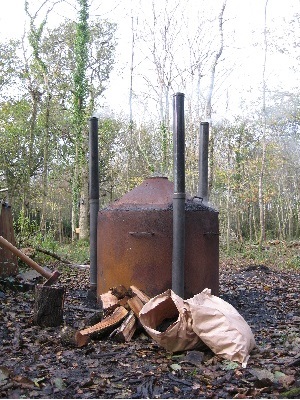Stover Country Park’s lump wood charcoal

Not all wood is charcoaled. Some wood is allowed to rot naturally on site in ‘habitat’ piles or dead hedges to increase dead and rotting timber for the benefit of wood boring invertebrates.
Historically, charcoal was used for smelting metal ores and producing lime from limestone which required very high temperatures.
The ‘charcoaling’ process
The wood is split evenly into logs, which are stacked very tightly in a kiln – the more wood that is stacked the more charcoal is produced.
The kiln is then left burning freely, allowing heat to build up at the base of the kiln. A lid is then placed on top and sealed with mud, restricting the oxygen flow to the fire and controlling the speed at which it burns. Vents around the base feed the fire with a restricted air flow, with temperatures potentially reaching 600° Celsius.
The heat from the fire burning at the base drives off all the moisture and gasses through flues. Once blue smoke is seen emerging from the flues, the kiln is closed down by sealing the vents and flues with mud. The kiln then carbonises the wood leaving lump wood charcoal.
The sustainable charcoal is then bagged and sold to generate income for future projects and maintenance in the Park. Bags are sold individually for £5.
Charcoal produced from native hardwoods is denser than other charcoals and burns very hot, keeping its heat, making it superb for BBQ cooking.